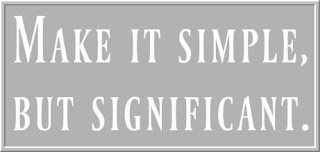We can develop our capacity for intentional activity by sustaining intentional activity. One routine that I like on the treadmill is to run with an uphill incline until I become tired and feel like quitting. Then I decide upon how much further to run. In other words, I sustain effort beyond the point of discomfort. That usually means breaking a good sweat.
The problem for most of us is that we rarely break a sweat--in trading or in other areas of life. We stay in our comfort zones and sustain an action until it becomes uncomfortable. So, for example, when writing my book I'll eventually become fatigued and feel like taking a break. That is when I most need to push further and write several more pages.
Similarly, I recently placed a few trades in the morning and got chopped up. I felt discouraged and decided it was best to pack it in. On reflection, however, I could tell that this was just discouragement talking; that, in fact, I was now seeing the market clearly. I pushed forward, redoubled my analysis, hit a point of clarity, placed one more trade, and profited nicely.
Now here's the interesting thing: When I push further and write a few more pages or do another lap on the treadmill, I break through my fatigue and often can do much more. After the winning trade, I was not deflated and discouraged at all and felt energized for the rest of my day. When we push past our comfort levels, we eventually tap into our second wind--a fresh source of energy and enthusiasm. When we continually make efforts to push past our comfort zones, we become increasingly capable of drawing upon that second wind of consciousness.
Every effort to sustain activity beyond our comfort zone is an exercise of will. We are energized when we tap our intentionality. We lose energy when we remain static, within what is familiar and comfortable. A great best practice--in trading and in life--is to break a sweat every day by sustaining effort beyond the comfort zone. As on the treadmill, we find that, over time, that comfort zone expands: what once took significant effort now comes readily. Note carefully: Every part of our trading processes--from our preparation to our reviews--can become opportunities to expand our capacity for effort when we push beyond our comfort zones.
That is the expansion of free will, and it underlies all success--in markets, and in life.
Further Resources:
Radical Renewal: Spirituality and Trading
Planned Trading and Intentionality
.







